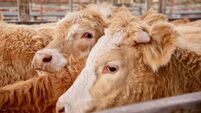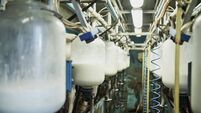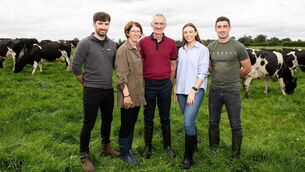A big cost is the loss of silage in storage
The December 2011 CSO livestock survey shows that the number of sheep increased by 6.4% or almost 200,000 over the previous year.
Dairy cows increased by 28,400 and male and female cattle under one year increased by 116,000 and 57,400 respectively so we definitely need more silage. Grass growth has not been great at times this year and obviously there are more livestock to graze what is available.
Farmers are better off to have some extra silage and avoid the need to purchase expensive concentrates next winter or spring. With a weaker euro feed millers will have to pay more for imported cereals and protein sources so this will push up compound feed prices.
So if at all possible livestock farmers need to conserve more forage and make some savings on purchased feed costs to minimise the impact of lower milk prices and increased costs for fuel, fertilisers etc. Farmers also need to focus more on silage quality while minimising costs at all stages.
A big cost is the loss of silage in storage. Clamp silage losses are often as high as 25% which is a huge cost so give this some thought. Wrapped silage bales are often left in the field for days (or sometimes weeks) before being moved and often to a poor storage site. This leads to wrap damage with oxygen entering the bale and significant losses in storage.
nBales v Clamp Silage
>>However if grass quality is good there is no difference between clamp and baled silage. studies conducted at Greenmount College (Antrim) and IGER (Wales) indicate no difference between the two in terms of animal performance and fermentation whereas dry matter losses were significantly lower in baled silage. (See table 1) Making bales can be at least as economical when crops are light, e.g., less than 10 tonne of fresh grass per acre. This is even more the case if wilting can be carried out as this reduces bales per acre.
nPoor Grass Growth HasImpacted on First Cut Silage Stocks
>>Due to poor grass growth in late spring many farms have grazed some or all the first cut silage area. First cut yields were also back by up to 50% in places due to poor growth rates. So you need to work out NOW how much silage you need next winter. Teagasc also advise farmers to plan for a reserve of winter feed for unforeseen issues, e.g., a month of bad weather, TB, etc.
So if 50% of the farm had the first cut in late May/early June, and the yield was well below average at 6 tonnes per acre, this cut would provide about 375 tonnes of silage- about 40% of the winter feed required. The remainder must be sourced between now and winter. So one option is to close a larger area for second cut silage, increase fertiliser usage on the grazing ground to allow for higher stocking rates and take out surplus grass as silage bales for winter feed.
Where forage is likely to be in short supply, aim for a good yield but plan to harvest by mid to late August as the land will be needed for grazing in September and October. Apply up to 100kg N / ha. which is 80 units of N / ac and the equivalent of 3 bags CAN per acre. If you close up ground that has already been harvested for a first cut, you could spread slurry on the bare stubble (not when there is an inch or two of re-growth) to avoid contamination of silage at harvesting.
Slurry will provide plenty of P & K for silage but will only provide about 0.3kg N / m3 or 3 units N per 1000 gal. Where 2000 – 3000 gal of cattle slurry has been applied per acre the chemical nitrogen can be reduced to 2.5 bags CAN (or equivalent) per acre.
Second cut silage has lower sugar content and could be more difficult to preserve so a short wilt would be beneficial. Aim to cut when there is a dry spell in prospect. Mow when the crop is dry and if possible harvest during a dry period but don’t leave the crop too long on the ground in broken weather.
Conditioning, wide spreading and tedding can all be used to assist a rapid drying process. Speed is important, as once the grass is cut, it starts to deteriorate so fast ensiling is essential to minimise nutrient losses. Rolling is required to avoid any air pockets. This is easier with shorter precision chop grass and the pit can also hold more silage. If air is allowed into the clamp, this will allow butyric acid to form and cause the top layer to decompose. Proper covering, tightening of the cover after a few days, wilting and the avoidance of soil and manure in the grass will all minimise butyric acid.
nConsider Using aSilage Additive
>>Quality additives can improve animal performance, milk quantity and quality, body condition and fertility. Studies at AFBI, Hillsborough have shown that, averaged over 11 studies, the milk yield benefit from an inoculant was 0.54 litres/cow/day with improved milk quality. Allowing for higher silage intake and the cost of additive this was worth £13.50/cow over a 150-day feeding period.
Silage fermentation can be divided into four phases. In the first phase excess oxygen can lead to unwanted protein breakdown, excessive heating and the growth of undesirable yeasts and moulds. Filling the silo quickly, distributing forage evenly in the silo, chopping grass to the correct length and ensiling at recommended dry matters, can eliminate oxygen at this stage.
The second phase of silage fermentation takes place under anaerobic (lack of oxygen) conditions. Undesirable micro-organisms can dominate if the pH does not drop rapidly. Where weather permits, wilting grass to 25-30% DM can eliminate these problems.
Lack of oxygen prevents the growth of yeast and moulds and the low pH inhibits the growth of most bacteria during the third phase. Silage can be kept for long periods of time if these conditions prevail. The last stage of silage fermentation is during feed out and exposure to air. Good silage will remain stable and not change in composition or heat during the third and fourth stages. Airtight silos and correct silo management during feed-out can prevent aerobic spoilage.













